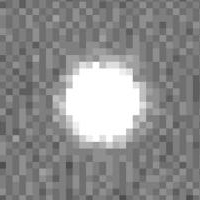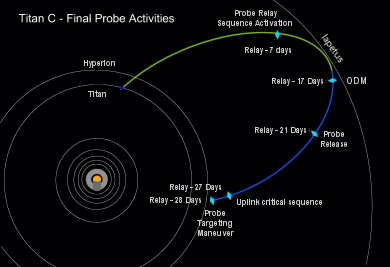Huygens Probe Separation and Coast Phase
Huygens Release
The second Titan flyby on 13 December 2004, placed the Cassini-Huygens spacecraft on a trajectory that, uncorrected, would lead to a subsequent flyby at an altitude of about 4600 km. A targeting manoeuvre was required, therefore, to achieve the desired interface conditions for the Huygens prboe.
The probe targeting manoeuvre was executed on 17 December 2004 and placed Cassini-Huygens on a direct impact trajectory with Titan. Such a manoeuvre was necessary as once released there was no way of changing Huygens' trajectory. Final commands were sent to Huygens on 21 December 2004 including the setting of the Mission Timer Unit (MTU). The MTU activated about 5 hours before the Huygens reached the interface altitude of 1270 km above Titan's surface.
On 25 December 2004 at 02:00 UTC the Spin/Eject Device (SED) separated Huygens from Cassini with a relative speed of approximately 0.35 ms-1 and a spin rate of 7.5 rpm. The orbiter targeting is such that the velocity increment provided by the SED springs provides the final targeting to the entry aimpoint.
The spin-stabilized Probe was targeted for a southern-latitude landing site on the dayside of Titan. In order to meet the probe dynamic entry conditions, minimize trajectory dispersion and thus enhance data relay link performance, the probe entry angle into the atmosphere was set at a relatively steep at -65° + 3° (99% certainty). This entry angle would also give the Huygens probe the best opportunity to reach the surface.
The Orbiter's Reaction Control System (RCS) was used to control the combined spacecraft attitude immediately prior to the separation event. RCS control algorithms maintain the spacecraft attitude and rate about all three spacecraft axes. Following the turn to the probe separation orientation, sufficient time was allowed for the spacecraft to attain a quiescent state with rates below 0.01 degrees per second on all axes.
 |
|
The Huygens probe imaged by Cassini 12 hours after separation |
The Huygens separation is a strenuous event for Cassini, and attitude control must be configured accordingly. The Orbiter's Attitude Control Subystem (AACS) switched to coast mode 10 seconds before probe separation. [In coast mode the RCS thrusters are inhibited from firing.] The RCS thrusters were re-enabled around 60 seconds after Huygens separation.
There was no communication between the spacecraft and the Earth while Cassini-Huygens conducted the probe release, with all telemetry recorded for later playback.
Cassini Orbiter Deflection Manoeuvre
The last two manoeuvres for Cassini before Huygens entry, the Orbiter Deflection Manoeuvre (ODM) and cleanup, set Cassini on a trajectory allowing targeting at atmosphere interface point and achieve the radio relay link geometry. The ODM was executed on 28 December. The manoeuvre, at about 24 ms-1, corrected the Cassini trajectory to flyby Titan at an altitude of 60 000 km and delayed the closest approach to until around two hours after Huygens reached the entry interface. The relative position of Cassini, Huygens and Titan enabled a theoretical maximum coverage of 4 hours 30 minutes.
 |
|
Probe activities leading up to the descent on 14 January 2005. (Image courtesy NASA) |
Probe Relay Critical Sequence
Cassini's background sequence S07 began on 16 December, and contained the bulk of the critical probe activities, including release and descent of Huygens. Because of the numerous sequencing activities, the background sequence was divided into three sections (A, B, and C).
On 16 December the Solid State Recorders (SSRs) were set to the configuration used to record data during probe descent. The first two telemetry partitions (#4 and 5) were each sized with enough capacity for the probe mission plus a 15% buffer. The third telemetry partition (#6) continued to store real-time engineering data as usual.
The probe relay critical sequence, for communications between the Huygens Probe and Cassini Orbiter during the approach to Titan and descent in the atmosphere, was uplinked separately from the background sequence S07 on 18 and 19 December.
Iapetus Observations
One week after Huygens release, Cassini made a flyby of Iapetus at an altitude of 117 500 km. Iapetus orbits Saturn at a distance of over 3.5 million km and this was the only opportunity before a close-up view in 2007.
Timeline of Events
| UTC | Time wrt Entry | Event |
| 16 December 2004 | ||
| 13:22 | Cassini's Solid State Recorders repartitioned for Probe Relay | |
| 17 December 2004 | ||
| 03:45 | - 28d 05h | Probe Targeting Manoeuvre (OTM #8) ∆V = 11.9 ms-1 on main engine; targets Orbiter and Probe to probe entry target |
| 18 December 2004 | ||
| 18:00 | - 26d 15h | Uplink Probe Relay critical sequence Part 1 |
| 19 December 2004 | ||
| 18:00 | - 25d 15h | Uplink Probe Relay critical sequence Part 2 |
| 21 December 2004 | ||
| 05:30 | - 24d 04h | Load Probe Mission Timer Unit MTU = the Probe's "clock" which counts down to entry; Probe fully configured for separation |
| 23 December 2004 | ||
| 03:30 | - 22d 06h | Probe Targeting manoeuvre cleanup (OTM #9) |
| 19:52 | - 21d 13h | Probe separation go/no-go |
| 25 December 2004 | ||
| 00:00 | - 20d 09h | Probe release mini-sequence begins |
| 02:00 | - 20d 07h | Huygens Probe separates from Orbiter; Orbiter on thruster control |
| 02:22 | - 20d 07h | Orbiter returns to Earth-point. Communication restored after probe separation |
| 13:30 | - 19d 20h | Orbiter images probe with a 5x5 mosaic intended to capture probe ejection trajectory |
|
26 December 2004 | ||
| 20:00 | - 18d 13h | Probe receivers checked out |
| 28 December 2004 | ||
| 03:00 | - 17d 06h | Orbiter Deflection Manoeuvre ∆V = 24 ms-1 on main engine; retargets Orbiter for 60 000 km flyby and relay |
| 31 December 2004 | ||
| 01:30 | - 14d 08h | Probe release mini-sequence ends; Iapetus mini-sequence begins |
| 07:03 | - 14d 02h | Saturn apoapsis, start of orbit C at a distance of 60 Saturn radii |
| 1 January 2005 | ||
| 01:37 | - 13d 07h | Iapetus 117 500 km flyby at 2.0 kms-1, 94 deg phase |
| 2 January 2005 | ||
| 04:38 | - 12d 04h | Iapetus mini-sequence ends |
| 4 January 2005 | ||
| 03:00 | - 10d 06h | Orbiter Deflection Manoeuvre cleanup (OTM #10A) |
| 6 January 2005 | ||
| 11:53 | - 07d 21h | Spacecraft configured for Probe Relay. All instruments off except MAG (on, muted), VIMS (sleep, muted) |
| 7 January 2005 | ||
| 09:00 | - 07d 00h | Probe Relay critical sequence begins: 8 day quiet period of minimal spacecraft activity before relay begins; Orbiter on thruster control |
| 14 January 2005 | ||
| 06:38 | - 02h 28m | Transition to thruster control for relay |
| 07:02 | - 02h 04m | Turn Orbiter to point to Titan |
| 09:06 | - 00h 00m | Probe reaches interface altitude; Entry altitude = 1270 km |
| 09:10 | Probe begins transmission to Orbiter | |
| 11:12 | + 02h 06m |
Titan-C flyby. Inbound 60 000 km flyby at 5.4 kms-1, 93 deg phase |
| 11:27 | + 02h 18m | Surface impact, end descent phase. Could vary ± 15 min depending on descent rate |
| 13:37 | + 04h 31m | Orbiter stops collecting probe data. Total 4 hours and 36 minutes of data collection |
| 13:47 | + 04h 41m | Turn Orbiter to point to Earth. Turn completes at 14:57 |
| 13:59 | + 04h 53m | Critical sequence ends |
| 14:00 | + 04h 54m | Post-probe tracking begins. Canberra 70m station receiving; 10 minutes for DSN lockup allocated |
| 16:57 | + 07h 51m | Ascending ring-plane crossing at a distance of 18.4 Saturn radii |
| 15 January 2005 | ||
| 12:23 | + 01d 03h | End nominal playback of probe data |
Note: Ground UTC is the time that the signal is received on Earth. The light travel time from the spacecraft to Earth is about 1 hour and 7 minutes.
Note: times represent scheduled mission time rather than actual time the event took place.
